Critical Structural Differences Between Seasonal and Pandemic Influenza
03/24/2020

Surface representation of the NS1 protein from the 1918 influenza virus with its three binding interfaces shown in color. The pandemic NS1 protein was found to be highly dynamic, whereas seasonal NS1 is mostly static, lending mechanistic insight into the infection severity of different influenza strains. [Reprinted with permission from Cho, J.-H., et al. 2020. "Molecular recognition of a host protein by NS1 of pandemic and seasonal influenza A viruses." Proceedings of the National Academy of Science USA 117 (12), 6550-6558. DOI:10.1073/pnas.1920582117.]
The Summary
Among all influenza pandemics, the 1918 influenza is considered the worst in human history. To investigate differences in virulence among influenza strains, researchers studied the nonstructural protein 1 (NS1) of the 1918 influenza strain and compared it to a seasonal strain. NS1 is an important factor influencing influenza infection severity because it antagonizes host defense mechanisms.
The researchers focused on NS1’s interaction with the human phosphoinositide 3-kinase (PI3K), to which NS1 binds through its p85β subunit, and presented the mechanism underlying the molecular recognition of p85β by NS1.
They found that the structure of 1918 NS1 is highly dynamic, whereas NS1 of a seasonal influenza strain is mostly static. Moreover, the respective NS1 proteins bind to p85β with drastically different binding affinities and kinetics.
The findings provide a mechanistic insight into strain-dependent behaviors of NS1 proteins, which remains elusive despite its importance in understanding the virulence of influenza viruses.
Related Links
- BER Resource: Center for BioMolecular Structure
- Feature Story: Scientists reveal a critical difference between the binding behaviors of seasonal and pandemic influenza
References
J.-H. Cho, B. Zhao, J. S.hi, N. Savage, Q. Shen, J. Byrnes, L. Yang, W. Hwang, P. Li. Molecular recognition of a host protein by NS1 of pandemic and seasonal influenza A viruses. Proceedings of the National Academy of Science USA 117 (12), 6550-6558 (2020). [DOI: 10.1073/pnas.1920582117]
